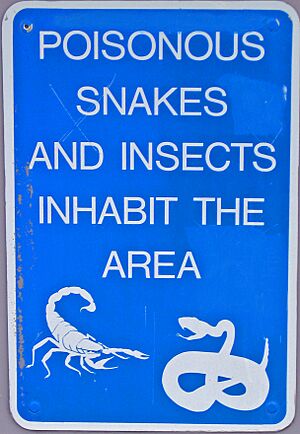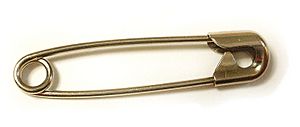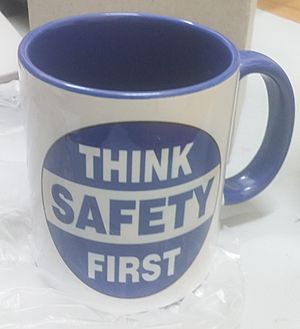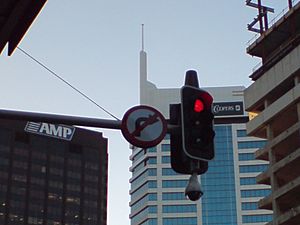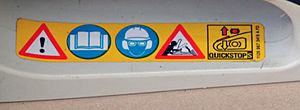Safety facts for kids
Safety means being protected from anything that could hurt you. It's about being "safe" and free from harm. Safety also involves managing known dangers to keep risks at a low and acceptable level.
Here are some examples of safety:
- Police work to keep public safety, which helps prevent crimes.
- Wearing a safety helmet protects your head from injuries.
- Your house keeps you safe from bad weather.
Contents
What Limits Safety?
Safety can sometimes be limited by certain rules or standards. These rules make sure that an object or organization works only as it's supposed to, without causing harm.
It's important to know that safety is not always perfect. It's very hard and expensive to remove all risks. A safe situation means that the chances of getting hurt or damaging property are low and can be managed.
When we say something is safe, it usually means it's safe within certain normal limits. For example, riding a bike is safe, unless you ride it on very rocky ground or in a way that could break it. Taking medicine is safe as long as you take the right amount.
Different Kinds of Safety
There are different ways to think about safety:
- Normative safety means a product or design follows all the right rules and standards for how it's made.
- Substantive safety means something has a good safety record in the real world, no matter if it meets all the standards or not.
- Perceived safety is how safe people *feel* something is. This doesn't always match how safe it actually is.
For example, traffic signals often feel safe. But sometimes, they can actually cause more car crashes at an intersection. On the other hand, traffic roundabouts often have a very good safety record, but they can make drivers feel nervous.
Public Safety and Security
This type of safety deals with the risk of harm from bad actions by others, like theft or vandalism. It's about keeping people safe in public places.
Ways to Improve Safety
Safety measures are actions we take to make things safer and reduce risks to people's health. Here are some common safety measures:
- Checking chemicals to make sure they are safe.
- Destructive testing where samples are tested until they break to see how strong they are.
- Drug testing for employees to ensure a safe workplace.
- Expert checks of activities to lower physical stress or make work more efficient.
- Geological surveys to check if land or water is polluted, or how strong the ground is for building.
- Government rules that tell companies what standards their products must meet.
- Instruction manuals that explain how to use a product safely.
- Instructional videos that show the correct way to use products.
- Internet safety or Online Safety, which protects you from online dangers like computer crime.
- Regular checks of people or departments to make sure everything is safe.
- Physical examinations to see if a person has any health issues that could cause problems.
- Process safety management is a way to prevent dangerous chemicals from leaking.
- Safety margins or Safety factors. For example, if a product is meant to hold 200 pounds, it might be designed to break at 400 pounds. This gives it a safety factor of two.
- Stress testing where a product is pushed beyond its normal limits to find its "breaking point."
- Training for workers or people using products to teach them how to be safe.
- Looking for dangers like emergency exits blocked by stored items.
- Checking for flaws like cracks or loose parts.
- X-ray analysis to see inside sealed objects, like welds or airplane parts.
Related pages
Images for kids
-
"After whiskey driving risky" Safety road sign in Ladakh, India


